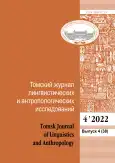№ 4 (2022)
ЛИНГВИСТИКА
ДИНАМИКА РАЗВИТИЯ ФЕДЕРАЛЬНОГО И РЕГИОНАЛЬНОГО ЯЗЫКОВОГО ЗАКОНОДАТЕЛЬСТВА В РФ: ОПЫТ РЕСПУБЛИКИ САХА (ЯКУТИЯ)
Аннотация
 9-26
9-26


МОЛОДЕЖЬ КОРЕННЫХ МАЛОЧИСЛЕННЫХ НАРОДОВ СЕВЕРА РЕСПУБЛИКИ САХА (ЯКУТИЯ): ЭТНОЯЗЫКОВАЯ ИДЕНТИЧНОСТЬ И РЕЧЕВОЕ ПОВЕДЕНИЕ
Аннотация
 27-40
27-40


КАК ИЗМЕНИЛИСЬ ЗНАЧЕНИЯ ЭСТОНСКИХ СЛОВ У НОСИТЕЛЕЙ, КОТОРЫЕ БОЛЕЕ 200 ЛЕТ НАЗАД ПЕРЕСЕЛИЛИСЬ В СТАВРОПОЛЬСКИЙ КРАЙ
Аннотация
 41-47
41-47


СЕМЕЙНО-ОБРЯДОВАЯ ТЕРМИНОЛОГИЯ ТОМСКИХ ТАТАР: МАТЕРИАЛЫ ЭТНОЛИНГВИСТИЧЕСКИХ ЭКСПЕДИЦИЙ
Аннотация
 48-58
48-58


ПРИЧАСТНЫЕ КОНСТРУКЦИИ СО ЗНАЧЕНИЕМ ОДНОВРЕМЕННОСТИ В КАЗЫМСКОМ ДИАЛЕКТЕ ХАНТЫЙСКОГО ЯЗЫКА
Аннотация
 59-72
59-72


“I GO DOWNSTREAM, AND YOU GO TOWARD THE SNOWSTORM”: EXPRESSIONS OF CARDINAL DIRECTIONS IN NGANASAN AND DOLGAN
Аннотация
This corpus-based study is dedicated to the topic of spatial orientation in two genetically unrelated but geographically neighboring languages, Ngnasan and Dolgan. Nganasan belongs to the Northern-Samoyedic branch of the Uralic language family, while Dolgan is a Turkic language. The Dolgans reached the peninsula later than the Nganasan and inhabited rather the eastern part. The goal is to typologically examine the linguistic realization of the directions of the so-called compass orientation. This is a very well-known fact that many indigenous languages, including many languages spoken in Siberia, do not know compass orientation. According to Brown (1983), speakers of many indigenous languages use three or only two cardinal points, however, in many languages, the speakers do not necessarily use the names of the compass direction but apply other concepts for expressing spatial directions. Brown (1983) identifies several sources of lexemes expressing the cardinal points, such as celestial bodies, which is the most often used source. It also occurs in the Samoyedic languages, e.g. in Selkup, but as we will see, not in the closely related Nganasan. Atmospheric features such as wind, seasons, blizzards, or environment- specific features such as a mountain, forest, or tundra can be metaphorically extended, thereby acting as the conceptual source of cardinal directions. The study follows Brown's typologization and tries to classify the results into their typological categories. We will find similarities and differences between the two languages regarding the conceptual sources. Both languages rely on the so-called landmarks for orientation in the surrounding areas, such as tundra, forest, river, or mountain, but beyond that, Nganasan uses other, non-common categories as well. These reflect a connection to their way of life; thus, it can be interpreted as a culture-specific source, which in turn has its origin in the environment. In contrast, the Nganasans do not use rivers as orientation points at all, although they live partly on the same rivers. Also typical only for the Nganasan is the use of atmospheric features a conceptual source. It does not play a role in any way in the Dolgan.
 73-83
73-83


АНТРОПОЛОГИЯ
О ПЕРСОНАЖЕ БАШКИРСКОЙ МИФОЛОГИИ АЖДАХА
Аннотация
 84-94
84-94


ПЕРСПЕКТИВЫ РАССМОТРЕНИЯ КУЛЬТУРНОЙ ТРАВМЫ В СВЕТЕ ЭКЗИСТЕНЦИАЛЬНОГО ПОДХОДА НА ПРИМЕРЕ ПРОЦЕССА АДАПТАЦИИ МИГРАНТОВ К СОЦИОКУЛЬТУРНЫМ УСЛОВИЯМ МАЛОГО ГОРОДА (НА ПРИМЕРЕ ГОРОДА ЧИТЫ ЗАБАЙКАЛЬСКОГО КРАЯ)
Аннотация
 95-102
95-102


СОВРЕМЕННЫЕ (НЕО) ШАМАНЫ ГОРНОЙ ШОРИИ
Аннотация
 103-110
103-110


«ТЕЛО» В ТРАДИЦИОННОМ ЭТИКЕТЕ БАШКИР
Аннотация
 111-120
111-120


НОВЫЕ МАТЕРИАЛЫ ИЗ МЕСТОНАХОЖДЕНИЯ КАМЕННОГО ВЕКА АРЫШЕВСКОЕ 2 В ДОЛИНЕ Р. ЯЯ (ТОМСКАЯ ОБЛАСТЬ)
Аннотация
 121-133
121-133


ОБРАЗ ИСТОРИЧЕСКОЙ РОДИНЫ В ИСТОРИЧЕСКОЙ ПАМЯТИ СОВРЕМЕННЫХ СИБИРЯКОВ СКВОЗЬ ПРИЗМУ МЕМУАРНЫХ ТЕКСТОВ (НА МАТЕРИАЛАХ ТОМСКОЙ ОБЛАСТИ)
Аннотация
 134-142
134-142


ЭТНОЛОГИЧЕСКИЕ МОТИВЫ И МИФОЛОГИЧЕСКИЕ ПЕРСОНАЖИ В ВЕПССКОЙ ПРОЗЕ
Аннотация
 143-150
143-150


СООБЩЕНИЯ
 151-153
151-153












